AASHTOWare Project BAMS/DSS™ (BAMS/DSS) was developed in the early 1980s by Infotech’s founders, Dr. James McClave and Dr. Tom Rothrock. BAMS/DSS was the first ever computerized system for collusion detection, and in all the years following, no other firm has been able to produce such a system. AASHTO acquired BAMS/DSS from Infotech in 1985. Infotech agreed to sell BAMS/DSS to AASHTO in order to protect the analysis methodology and output so non-AASHTO members could not acquire BAMS/DSS. Before the sale of BAMS/DSS, a major highway contractor actually approached Infotech wanting to license or acquire BAMS/DSS with the reason that it thought BAMS/DSS would help it on estimating contracts. Obviously, this firm mainly wanted to know the analysis methodology BAMS/DSS used to evaluate competition so it would know how to circumvent the analysis. As an analogy, your home security system is not effective if you have a diagram of the system posted on your window so intruders would know how to circumvent the security system.

Since the sale of BAMS/DSS, Infotech has continued to be AASHTO’s developer and support firm for BAMS/DSS. BAMS/DSS has survived all these years but will soon be replaced by the AASHTOWare Data Analytics™ module that is currently being developed by Infotech.
Market Analysis Training (MAT) Background
Annually since 1996, Infotech has provided a Market Analysis Training (MAT) session that is attended by Department of Transportation (DOT) agencies that license the BAMS/DSS product. The first day of the MAT is an overview of the basic methodology of performing market analysis. The second day is a brief overview of how to use the BAMS/DSS models for market analysis. The third day is attendees using its own DOT data to run and evaluate BAMS/DSS output on its own with assistance from Infotech.
Over all these years, the MAT has been popular with DOT attendees, and we often have repeat attendees. In several cases, attendees that learn the market analysis methodology, realize that its agency may have competition issues and employ Infotech to provide a market analysis for them. These agencies hire Infotech because it does not have dedicated staff to do this, nor staff experienced enough to do a proper market analysis. The following details one such case in West Virginia.
The 2014 MAT
John E. Taylor (the West Virginia DOT Contract Engineer) attended the 2014 MAT (Feb 11 – Feb 2014). After learning more about the market analysis methodology, Mr. Taylor was convinced that his agency probably had competition issues. Mr. Taylor felt that he needed additional support to convince WVDOT management, so he started discussing this with me on approaches.
The High-Level Market Analysis
We previously had another agency that believed it may have competition issues on asphalt paving contracts. What we did for this agency was obtain its BAMS/DSS data and do a high-level or preliminary market analysis. A high-level analysis is typically limited to a short time frame of three months. Afterwards we provide the agency a one-day presentation of market analysis methodology (like we do at the MAT), and the second day, show the agency our preliminary analysis of the agency's data.
Obviously, due to the short timeframe, the high-level analysis is not as robust as an in-depth analysis that often takes ten months or more but does provide a very good overview of its competition on the specified contract work type – which for almost all DOT agencies is asphalt since it accounts for the largest portion of the agencies’ program dollars.
This approach was discussed with Mr. Taylor at WVDOT.
WVDOT On-site MAT
After getting WVDOT data and performing the high-level analysis, Dr. James McClave and I provided an on-site MAT to WVDOT during Nov 17 – Nov 19, 2015. These sessions were attended by approximately 50 WVDOT personnel including district people (this is one advantage of having an on-site MAT, since attendees do not have to travel to our office in Gainesville, Florida).
During the second day, while I was presenting the preliminary analysis of the WVDOT data, Paul A. Mattox, the Secretary of Transportation and Commissioner of Highways briefly attended just before our lunch break. At the lunch break Mr. Mattox approached Dr. McClave and me and said he wanted a briefing later that day. We asked him when, and he said whenever you are done for today. We next asked, “how long do we have?" He replied, “as long as you need.” This completely floored Dr. McClave and I, because in the past (and since), we never got this type of access to a Secretary of Transportation.
Obviously, Dr. McClave and I de-briefed the Secretary and his deputy. This was received very well.
Though normally not done on an on-site MAT, I was scheduled to provide BAMS/DSS training on the third day. At the start of the third day, Mr. Taylor told us that plans had changed, and we needed to provide a debriefing to the Secretary and additional WVDOT management, that also included the area head of the FHWA.
We provided a more in-depth debriefing to this group. Mr. Mattox asked for recommendations. I told him that a formal in-depth analysis should be done, but also recommended that the analysis include data from DOT agencies surrounding West Virginia (Ohio, Kentucky, Virginia, Maryland, and Pennsylvania). Mr. Mattox didn’t bat an eye and immediately told us to proceed, without asking what the potential cost may be. This again floored Dr. McClave and I, but obviously the preliminary analysis was compelling. Mr. Taylor was ecstatic with the result and said that this turned out better than he could have ever expected.
By the way, though it did not include a DOT Secretary, we also received approval for an in-depth analysis for the previous agency after we provided a high-level analysis and on-site MAT. The high-level analysis using the agency data really helps an agency determine if it has competition issues.
The WVDOT Analysis
Since Infotech had a supplemental support agreement with WVDOT, we were able to proceed immediately with analysis.
We asked WVDOT to request BAMS/DSS data from the surrounding states. As we found with previous analyses, other DOT agencies are very willing to provide data for such an analysis. For the surrounding states data, we do not do a full analysis, but we determine things like market areas, vendors bidding, and commodity prices to compare with the target agency. This process tremendously improves the analysis for the target agency.
What we found was WVDOT had much higher asphalt prices even though, due to its asphalt mixes, prices should have been lower as shown below.
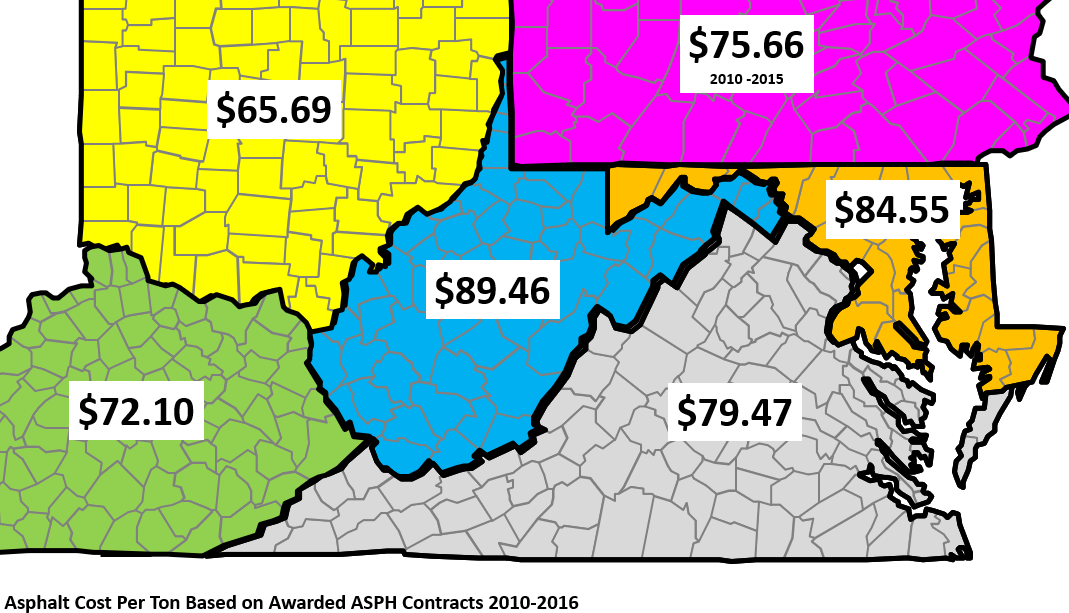
*Click on the image for greater detail
In October 2016, our WVDOT analysis was almost complete. On Oct 12, 2016, four WV cities (Charleston, Parkersburg, Beckley and Bluefield) filed a lawsuit against the very vendors we were investigating and for asphalt paving. On Oct 14, 2016, the WVDOT filed a lawsuit against these same vendors, but did so without consulting the WV AG (Patrick Morrisey).
The above was just before an election where the WV AG was up for re-election.
After Patrick Morrisey was re-elected in Nov 2016, a revised lawsuit was filed in Jan 2017 against CRH, PLC; Oldcastle, Inc.; Oldcastle Materials, Inc.; West Virginia Paving, Inc.; Southern West Virginia Paving, Inc.; Southern West Virginia Asphalt, Inc.; Kelly Paving, Inc.; Camden Materials, LLC; American Asphalt & Aggregate, Inc.; American Asphalt Of West Virginia, LLC; Blacktop Industries and Equipment Company.
The WV AG’s office did not have staff to conduct the lawsuit and contracted with Bailey & Glasser law firm which had filed the lawsuit for the aforementioned WV cities. On May 25, 2017, Bailey & Glasser hired Infotech for support analysis.
The Lawsuit Analysis
One of the first things that we did was obtain data for 2016. This showed that WVDOT asphalt prices dramatically decreased in 2016 after it was known that an investigation started as shown below.
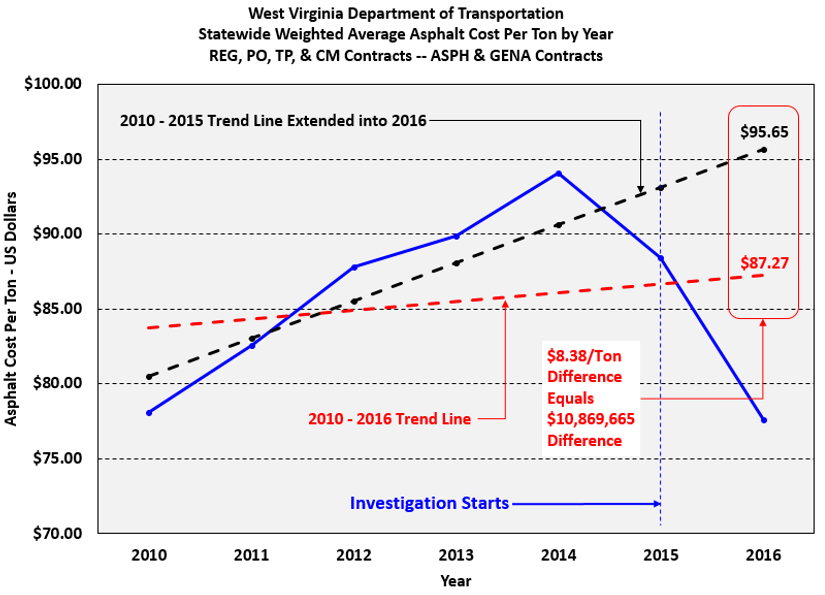
*Click the image for greater detail
Note in the above, WVDOT saved nearly $11 million before this case went to trial, simply due to the fact the contracting community knew an investigation had started. The contractors would likely claim that the decrease was due to reduced oil prices - those decreases started in 2014, but since an investigation had not been started, the prices continued to increase into 2015.
Changing bidding behavior after an investigation has started is a huge “red flag.” Back in the early 1980s bid rigging cases, lawyers would coach defendants that they didn't want to know if you colluded or not, but if you have, don’t change what you’re doing. This message was not heeded by the WV contractors.
During the case after the lawsuit, we learned through discovery that two of the major asphalt vendors had actually formed a joint venture to eliminate competition.
The below shows two major vendors (West Virginia Paving and Kelly Paving) before the joint venture.
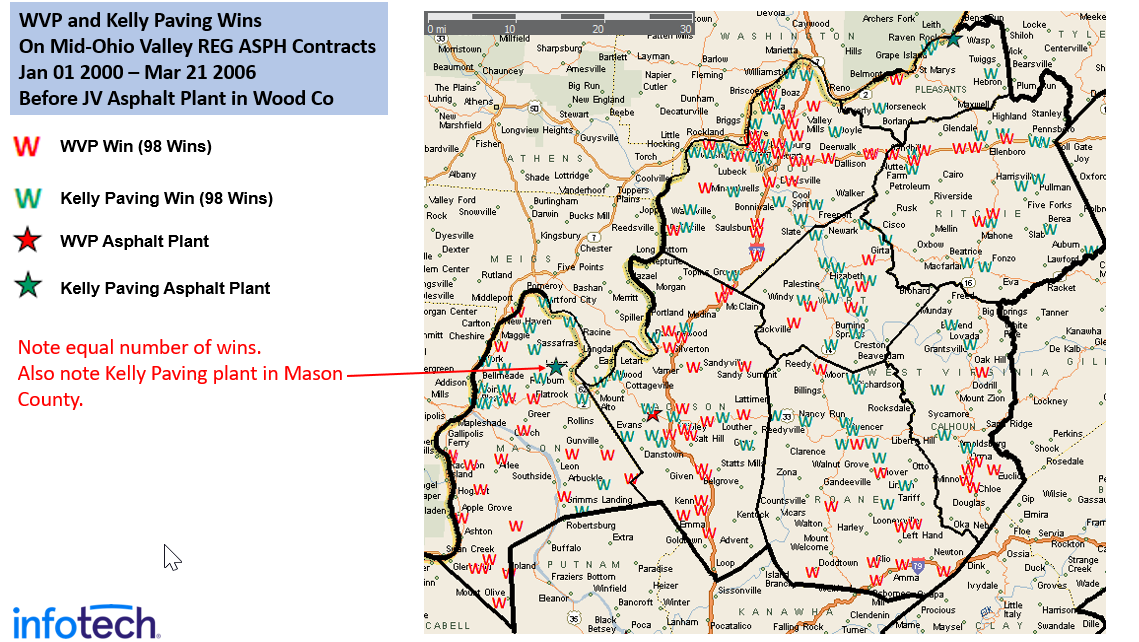
*Click the image for greater detail
Note in the above, due to Kelly Paving’s plant in Mason County, it gave West Virginia Paving significant competition.
The below shows what happened after the joint venture.
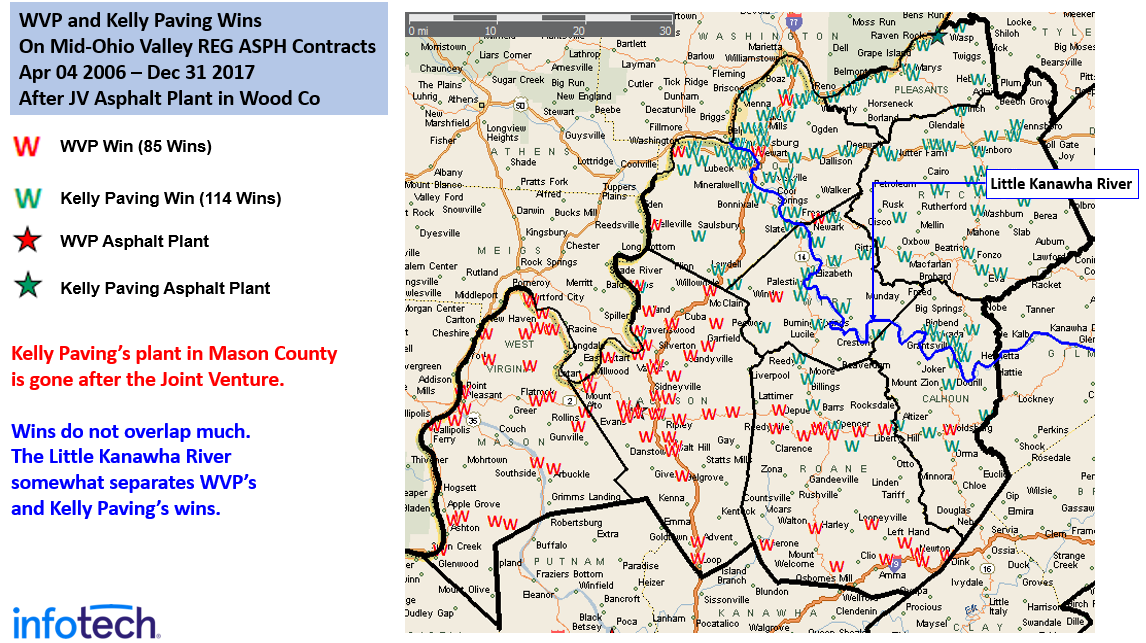
*Click the image for greater detail
Note in the above, Kelly Paving’s Mason County plant is gone. Wins are lopsided, but it does not much matter, since now Kelly Paving and West Virginia Paving are splitting contract dollars.
The above is just a couple of exhibits we had prepared for the trial. Due to discovery, the defendants also saw these damaging exhibits. Nevertheless, the defendants dragged this case out for as long as possible.
Late in case, Dr. McClave was deposed twice, each one spanning approximately eight hours. I was also deposed (my first) for about eight hours. While depositions are “old hat” for Dr. McClave’s experience of doing this for more than 40 years, it was very stressful for me! Another Infotech employee, Cliff Yuill (who had no involvement in the case) was also deposed. Particularly after Dr. McClave’s first deposition, the others were unnecessary – there was nothing I can tell them that Dr. McClave had not already – I believe the lawyers hoped I would contradict Dr. McClave. There was equally nothing Dr. McClave could relate in the second deposition. These were delaying tactics.
One last delaying tactic attempt was to file a Daubert motion against Dr. McClave. This basically states Dr. McClave was not qualified to testify in such a case, which was ridiculous since Dr. McClave has done this for many years, and the lawyers knew this.
Finally, the defendants settled the case for $101,350,000 on October 29, 2020. This was the highest antitrust settlement in West Virginia history. The settlement could actually have been higher but WV law limits damages to a four-year period after the lawsuit is filed. We had WVDOT data going back to 1996 that showed competition issues on asphalt paving.
This whole case occupied six and a half years of my life, but I love this kind of work. I had the most data ever, and there was never a dull moment. If you’re interested in taking a deeper look at your data, Infotech can help. Reach out to us at dataservices@infotechinc.com for more information.
Authors
Jeff Derrer
DATA SERVICES CONSULTANT
Jeff Derrer has more than 30 years of experience in transportation project management and engineering. He has been a Senior Consultant with Infotech since 2001, providing data analysis services to state transportation agencies. He previously worked for the North Carolina Department of Transportation as Head of the Contract Monitoring Section for more than 10 years, and for the Virginia Department of Transportation as Head of the Antitrust Section for four years. In those roles, he directed activities that analyzed contractor’s bids to ensure a competitive market place.
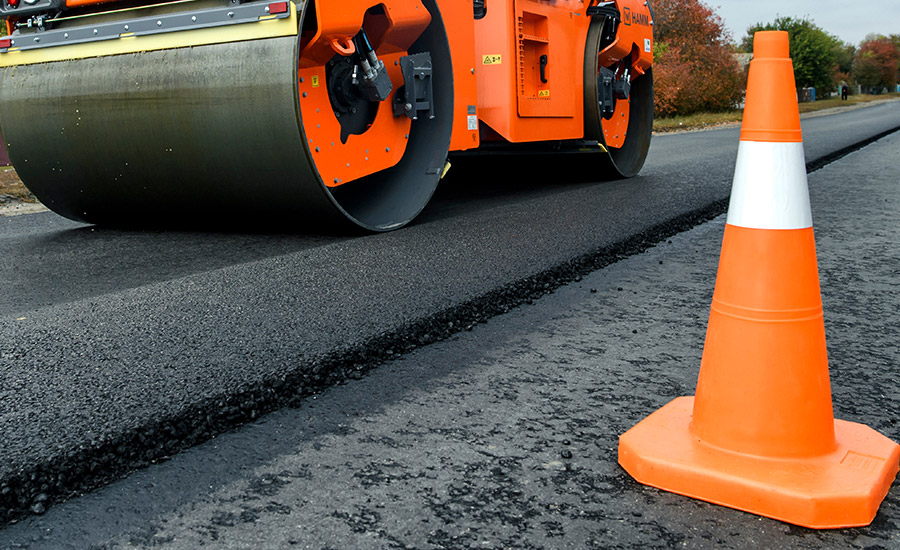

Post a comment to this article
Report Abusive Comment